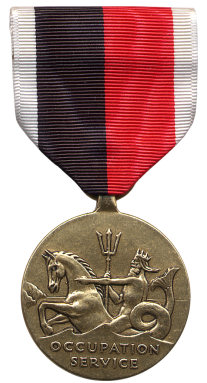Navy Occupation Service Medal
|
 |
|
1. Description: Army - The bronze medal is 1 ¼ inches in width. On the obverse is Neptune mounted on a composite creature of a charging horse and a sea serpent with a trident grasped in right hand above wave scrolls. Around the bottom of the medal are the words "OCCUPATION SERVICE". The reverse is the same as the China Service Medal and is an eagle perched on the shank of a horizontal anchor with a branch of laurel entwined around the anchor. On the left is the word "FOR" and to the right is the word "SERVICE" and around the top is the inscription "UNITED STATES NAVY". 2. Ribbon: The ribbon is the same for both medals and is 1 3/8 inches wide and consists of the following stripes: 3/16 inch White 67101; ½ inch Black 67138; ½ inch Scarlet 67111; and 3/16 inch White. 3. Criteria: The medal was awarded for 30 days consecutive service while assigned to: a. Germany (excluding Berlin) between 9 May 1945 and 5 May 1955. Service between 9 May and 8 November 1945 will count only if the EAME Campaign Medal was awarded for service prior to 9 May 1945. b. Austria between 9 May 1945 and 27 July 1955. Service between 9 May and 18 November 1945 will count only if the EAME Campaign Medal was awarded for service prior to 9 May 1945. c. Berlin between 9 May 1945 and 2 October 1990. Service between 9 May and 8 November 1945 may be counted only if the EAME Campaign Medal was awarded for service prior to 9 May 1945. d. Italy between 9 May 1945 and 15 September 1947 in the compartment of Venezia Giulia E. Zara or Province of Udine, or with a unit in Italy designated in DA General Order 4, 1947. Service between 9 May and 8 November 1945 may be counted only if the EAME Campaign Medal was awarded for service prior to 9 May 1945. e. Japan between 3 September 1945 and 27 April 1952 in the four main islands of Hokkaido, Honshu, Shikoku and Kyushu; the surrounding smaller islands of the Japanese homeland; the Ryukyu Islands; and the Bonin-Volcano Islands. Service between 3 September 1945 and 2 March 1946 will be counted only if the Asiatic-Pacific Campaign Medal was awarded for service prior to 3 September 1945. f. Korea between 3 September 1945 and 29 June 1949. Service between 3 September 1945 and 2 March 1946 will be counted only if the Asiatic-Pacific Campaign Medal was awarded for service prior to 3 September 1945. 4. Components: The following are authorized components: a. Medal (regular size): MIL-DTL-3943/246. Medal set with full size medal and ribbon bar. NSN 8455-00-269-5763. b. Medal (miniature): MIL-DTL-3943/246. Available commercially. c. Ribbon: MIL-DTL-11589/112. NSN 8455-00-265-4910. Available commercially. d. Foreign Service Clasp: MIL-DTL-41819/9: Germany - NSN 8455-00-249-0171; Japan - NSN 8455-00-249-0172. e. Berlin Airlift Device: MIL-DTL-41819/13. Regular and miniature sizes. NSN 8455-00-261-4504. 5. Background: a. The Army Occupation Medal was established by War Department Circular 102, dated 5 April 1946. b. The medal was designed by Mr. Thomas Hudson Jones and the first medal was presented to General Eisenhower on 2 April 1947. The ribbon design uses the color black to represent Germany and the color red to represent Japan. c. On 4 February 1948, the Secretary of the Navy requested the Heraldic Section, Department of the Army, design a suitable Navy Occupation Service Medal. This medal was designed by Mr. Thomas Hudson Jones on 30 March 1948. d. The service clasp is worn on the suspension ribbon to indicate area of occupation. The Berlin Airlift Device is a miniature of a C-54 type aircraft and is worn on the suspension ribbon and service ribbon to indicate 90 days consecutive service between 26 June 1948 and 30 September 1949. |
|